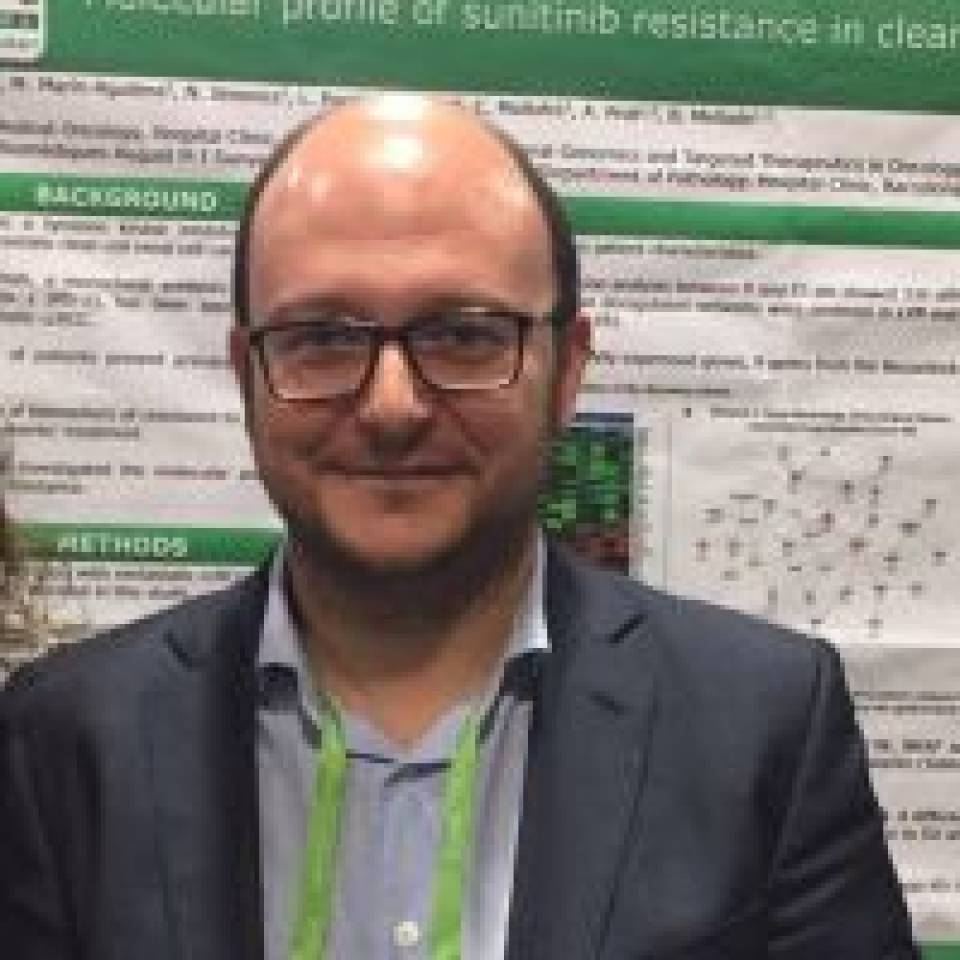Treatment of kidney cancer
The treatment of this type of tumour depends mainly on the aforementioned clinical classification; however, other parameters must also be evaluated: such as the patient's age, other diseases present and the function of the kidney itself.
Surgical treatment
Treatment of localised tumours
In most cases, the treatment of tumours located in just one organ (in this case, the kidney) is surgical and consists of removing the tumour. Depending on the size of the tumour, its location or extension, either partial surgery (removing the tumour and leaving the rest of the kidney) or radical surgery (removing the entire organ) may be performed.
This can be done using laparoscopy, robotics or as open surgery. Both laparoscopic and robotic surgery use small incisions to insert trocars (plastic or metal tubes) that pass through the abdominal cavity to introduce gas and form a working space (pneumoperitoneum). A camera and instruments to perform the surgery can be inserted through these tubes.
Once the tumour is removed (either partially or entirely), it is placed inside a bag and removed through an enlargement of one of the cuts. Sometimes a plastic tube (for drainage) is left at the end of the surgery.
The most common complications of surgery are bleeding and infection. There may also be deterioration in final kidney function whose importance depends on the previous condition of each patient.
Pathological analysis of the tissue that has been removed can provide information about the cell type, the degree of differentiation of the cells (aggressiveness), involvement of surrounding structures and a classification of the tumour into risk groups, which help in the follow-up plan.
Certain elderly patients, or those with relevant associated pathology, who have small kidney tumours (of less than 3 cm) can be considered for ablative surgical techniques, such as radiofrequency and cryotherapy. These techniques destroy the tumour tissue less aggressively, via heat and cold, respectively.
Another treatment considered for this same situation, of small tumours of less than 4 cm, is active surveillance, which means monitoring the tumour using imaging tests to see if it significantly increases in size (greater than 0.5 cm per year), whereupon surgery can be performed.
In cases where surgery has been performed with curative intent, the application of pharmacological treatment after the operation has been studied to prevent relapses; although current treatments (Sunitinib, Pazopanib, Sorafenib and Axitinib) have not been shown to be effective for this. Therefore, after surgery, the disease is monitored only (by imaging techniques and analytical controls) without applying any medication.
Treatments for metastatic tumours
Tumours can spread to other organs or to the lymph nodes; when this happens, it is called metastatic disease. The tumour in the kidney is the primary tumour and the lesions in other locations are called metastases. For patients with metastases, other clinical factors, in addition to the extent of the disease, must be taken into account when choosing the best possible treatment. These factors include the general condition of the patient, whether or not surgery has been performed on the primary tumour and analytical determinations, such as the presence of anaemia or elevated inflammatory or calcium parameters, for example. Depending on these parameters, patients can be classified into three groups: favourable, medium or poor prognosis.
For patients with an initial diagnosis of metastatic kidney cancer with a favourable or intermediate prognosis, surgery on the primary tumour may be considered to reduce its volume as much as possible, as well as to alleviate symptoms that go with the primary tumour itself, such as pain or haematuria.
For very selected cases with a single metastatic lesion which is detected and accessible, surgical treatment will be considered; thus lessening or delaying the need for drug treatment.
Pharmacological treatment
Whether surgery is performed or not, the treatment of metastatic disease is based on the administration of drugs. These drugs are distributed through the bloodstream and so reach the entire body, acting on all the metastases the patient may have; for this reason, it is called systemic treatment.
The goals of systemic treatment are to extend the life of patients, reduce the size of the primary tumour and metastases and improve the symptoms of the disease and quality of life of patients.
Renal tumours are not sensitive to what is popularly understood as classical chemotherapy (cytotoxics) but are sensitive to other types of drugs. There are three large families of drugs that have shown efficacy in these types of tumours: Antiangiogenics, immunotherapy and mTOR inhibitors.
One of the fundamental processes involved in kidney tumours is the creation of new blood vessels for the tumour itself, so that it can grow from the nutrients and oxygen that reach it. This process is known as angiogenesis. Thus, drugs have been developed to act mainly on blood vessels to prevent their development. Examples of this family of drugs are sunitinib, pazopanib, axitinib and cabozantinib.
Immunotherapy is the administration of drugs that work by activating the patient's own immune system (“the defences”) to attack the tumour. Immunotherapy has been known for decades to be effective in kidney tumours, since very early studies showed how the administration of interferon or interleukin-2 could control the disease in a subgroup of patients of high toxicity. New immunotherapies that act by inhibiting certain molecular pathways (PD1/L1 and CTL4) have shown greater benefit and less toxicity, and these are one of the standard treatments for this type of tumour.
Another family of drugs that has shown efficacy in kidney cancer are mTOR inhibitors, such as everolimus and temsirolimus. However, due to the greater efficacy of antiangiogenic drugs, the use of these drugs has been reduced.
More recently, clinical trials have shown how different combinations of immunotherapy drugs can show greater efficacy than treatment with single antiangiogenic agents alone. For example, nivolumab / ipilimumab, pembrolizumab / axitinib, pembrolizumab / lenvatinib or nivolumab / cabozantinib. Thus, these new combinations are the recommended first-line treatment for metastatic kidney tumours, but are not yet fully available for healthcare.
It should be noted that pharmacological treatment depends on a number of factors, such as the general condition of the patient, symptoms secondary to the disease, the kidney cancer subtype, its extent, other diseases the patient may have, and the availability of the different drugs or clinical trials.
Side effects
Different pharmacological treatments for the disease as well as the disease itself can cause the following side effects:

Arterial hypertension: This is the most common side effect of antiangiogenics. Therefore, it is recommended to measure blood pressure periodically during treatment and record the values. Arterial hypertension developed by the patient is usually controlled by administering drugs. Complicated cases may require the cancer treatment to be stopped or a dose reduction of these drugs.

Decreased hunger and weight loss: A multidisciplinary team nurse weighs you before starting any treatment and will monitor your weight throughout the disease process. Nutrition is an important part of cancer treatment; eating properly and a balanced diet can help you feel better and have more energy. If necessary, you will be referred to the dietetic service.

Nausea and vomiting: There are medications to ease the feeling of nausea and vomiting. You should speak with the health team so they can assess the most appropriate treatment. There are also foods that have this property, such as ginger.

Diarrhoea: Diarrhoea is a common side effect of both antiangiogenics and immunotherapy. If there are more than 4 visits a day producing diarrhoea, you should contact the healthcare team.

Dry skin and pruritus (itching): Antiangiogenic agents can cause dry skin, so it is recommended to apply a moisturising cream all over the body. Pruritus is also a common side effect of these drugs and symptomatic treatment should be given.

Anxiety, fear, emotional stress and depression: You should discuss any of these problems with the multidisciplinary team treating you so they can refer you to the psychology-psychiatry service if necessary.

Fatigue (Tiredness): It is common for patients diagnosed with cancer to feel tired. You should discuss this with the health team so they can give you guidelines for eating, physical exercise and adequate distraction methods, so you can control fatigue and carry out your usual routine. If necessary, tests will be carried out, such as an analysis to rule out anaemia, and the patient will be referred to the corresponding professional or service.

Confusion or brain fog: People undergoing chemotherapy treatment may find some of their cognitive abilities altered. For example, attention span, mental flexibility, reaction time, information processing speed, visual and spatial memory and motor and verbal function may all be impeded. This is why patients should attend visits accompanied by family or friends to ensure they can process all the information given to them.

Infections and fever: The treatments used to cure or control kidney cancer often also affect the immune system, leaving the patient with their defences impaired to fight infections, which usually manifest as fever. It is vitally important that a patient with a temperature above 38ºC should go to the emergency room for an analysis and to administer antibiotics.
If any new symptoms appear during cancer treatment, you should contact the usual team for assessment and treatment.
Active surveillance
Some patients have a small number of small metastases. In this situation, radiological monitoring of the disease could be considered in order to delay the use of medical treatment and thus its adverse effects.
New treatments
Different drug combinations and new treatments are being studied for kidney cancer, including new immunotherapies, drug combinations and new drugs, such as HIF and MET inhibitors. Currently, all these new treatments are accessible only as part of clinical trials to evaluate their efficacy and safety.
Palliative treatment
In advanced stages of the disease, especially if it affects other organs, symptoms (e.g. pain, fatigue and anorexia) can appear that affect the patient's quality of life and must be treated to alleviate their effects.
The most frequent symptom found is pain, which can be treated with the usual analgesics and anti-inflammatories or more powerful analgesics (opioids) if these do not lead to improvement.
For bone pain due to metastasis, radiotherapy directed at the lesion has been shown to reduce pain and this can be performed.
Less frequently, a high blood calcium level or neurological symptoms due to extension of the disease in the brain can be found.
The appropriate treatment should be applied in each situation depending on each patient.
At these advanced stages of the disease, they will be referred to the palliative service (PADES) to monitor and treat both the patient and the family.
Substantiated information by:



Published: 1 February 2022
Updated: 1 February 2022
Subscribe
Receive the latest updates related to this content.
Thank you for subscribing!
If this is the first time you subscribe you will receive a confirmation email, check your inbox